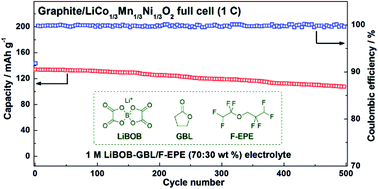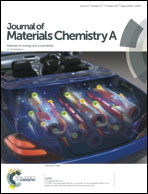A novel mixture of lithium bis(oxalato)borate, gamma-butyrolactone and non-flammable hydrofluoroether as a safe electrolyte for advanced lithium ion batteries†
Abstract
In this work, 1,1,2,2-tetrafluoroethyl-2,2,3,3-tetrafluoropropyl ether (F-EPE), a kind of non-flammable hydrofluoroether, was initially mixed with lithium bis(oxalato)borate (LiBOB) and gamma-butyrolactone (GBL) to formulate a safe electrolyte for lithium-ion batteries. It was found that the addition of F-EPE endowed this novel electrolyte with a high safety level, low surface tension and good wettability to the separator and electrodes. More importantly, this safe electrolyte supported the graphite/LiCo1/3Mn1/3Ni1/3O2 full cell in achieving excellent electrochemical performances. During the prolonged cycle test at room temperature, its capacity retention after 500 cycles could reach 80.6%, which was comparable to that of a commercial electrolyte. Its rate performance at room temperature and cycle performance at elevated temperature (60 °C) surpassed those of the commercial electrolyte. In particular, its low-temperature performance was remarkable, and the cell could deliver a capacity as high as 74.2 mA h g−1 at −40 °C. In view of these results, such a safe electrolyte showed tremendous potential for practical application.



 Please wait while we load your content...
Please wait while we load your content...